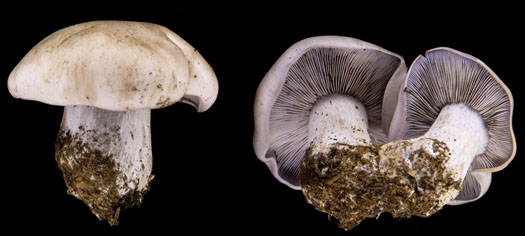Blewit eaters
 It seems I’m not the only one around here who likes blewits. Allan brought these over to me a while ago, just to check on them before they hit the frying pan. I like to take a spore print before I eat blewits, because around here we have some sneaky purple Cortinarius lookalikes. Once I’ve checked off the various blewit-identifying features, a spore print makes a good double-check to rule out those Corts: White or pinkish-white prints for blewits (Lepista nuda); rusty-brown for Corts. Don’t eat the Corts.
It seems I’m not the only one around here who likes blewits. Allan brought these over to me a while ago, just to check on them before they hit the frying pan. I like to take a spore print before I eat blewits, because around here we have some sneaky purple Cortinarius lookalikes. Once I’ve checked off the various blewit-identifying features, a spore print makes a good double-check to rule out those Corts: White or pinkish-white prints for blewits (Lepista nuda); rusty-brown for Corts. Don’t eat the Corts.
 Don’t eat raw blewits either, for that matter. They contain a toxin that attacks your red blood cells and generally makes you feel bad.
Don’t eat raw blewits either, for that matter. They contain a toxin that attacks your red blood cells and generally makes you feel bad.
But I digress.
I like blewits and Allan likes blewits but these blewits were already being eaten. The culprit was a fungus I’d never seen before. A big handsome mold of the sort that makes you think you really ought to know what it is so maybe there is a problem with your brain. So then you zip a picture over to the Friday Afternoon Mycologist to see what he will say. I guess his propeller was spinning awfully fast, because he quickly said “This is Harziella capitata Costantin & Matr., Bull. Soc. Mycol. Fr. 15: 107, 1899.” It happened just like that.
Like most of you, I have a copy of that mildewed publication right handy, and so I looked it up lickety-split and darned if that wasn’t just exactly it, described 107 years ago from a blewit in France.
It’s a mycoparasite–a black sheep of a fungus that eats its own kin. Now, parasites are just about my favorite things, and mycoparasites really can’t be beat. Once you start noticing them, they’re addictive. Lots of different fungi grow on other fungi–little fuzzy interlopers on somebody else’s fruiting bodies. Many mycoparasites are rather particular about what they eat. Perhaps this one’s a special parasite of blewits? I don’t know what else it’s ever been recorded from. I bet that some of you like blewits– next time you’re out picking, have a look, maybe you’ll find it too. Use your hand lens to look along the moldy gills for some teeny tiny little bottle brushes. You have a hand lens, right? If not, you’re really missing out.
Harziella capitata is seldom illustrated; I thought we all might want to admire it together. So here is the moldy blewit (top) and a couple of handsome conidiophores (bottom), popping up from the moldy gill surface. I admit that the poor blewit sat forlornly in the fridge for a few days before its celebrity was recognized and it sat for its portrait.
Photos by Kent Loeffler.
2010 Addendum: Here is a part of the original illustration of this fungus from that 1899 paper by Costantin and Matruchot. Looks like mine, doesn’t it! They found theirs in a bed of cultivated blewits at a Horticultural Expo in France, leading them to speculate that the mold might have come in with exotic plant material. From Fig. 5, you can see that the spores tend to accumulate in slimy droplets until you knock em off to make a slide.



Great post! I recently moved and haven’t yet found any blewit patches around here, but I have high hopes for next year. I’ll keep an eye out for Harziella, a new species for me to look for.
[…] Sometimes when you are asked to identify something, you just know what it is (see our Blewit eaters post). This exciting event is like immediately recognizing a person you have never seen before, but somewhere you heard about them or saw a picture. You don’t need to measure the length of their nose or examine their eye or hair color, you just know who they are. But when this spark doesn’t happen, you need to do the grunt work; make the slides, take the measurements, take the notes and hope it will lead you somewhere. With this particular fungus, already with the picture from last week, I knew that no key would help me identify this fungus. This is going to be a hard one, and in the end it might be a new genus and species. […]
In this post, I recommended one trusty source for Hastings triplet hand lenses (loupes, magnifiers). New Jersey Minerals offers a nice discussion and comparative review of a handful of other brands. A 10x lens is a good place to start–I like this one for price and its big diameter and ruggedness. I have a 20x lens on my lanyard, as well, but it’s so tiny that it’s only for true aficionados of the very small.